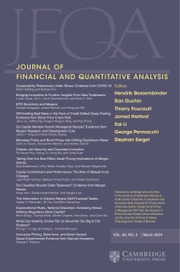No CrossRef data available.
Article contents
Equity Premium Predictability over the Business Cycle
Published online by Cambridge University Press: 02 September 2025
Abstract
Equity returns follow a pronounced V-shape pattern around the onset of recessions. They sharply drop into negative territory just before business cycle peaks and then strongly recover as the recession unfolds. Recessions are typically preceded by a flat yield curve. Probit models relying on the term spread as a predictor therefore time the beginning of recessions well. We show that model-implied recession probabilities based on the term spread strongly improve equity premium prediction in- and out-of-sample and outperform several benchmark predictors. Correcting for a structural break in the mean of the term spread in 1982 further strengthens the forecast performance.
Information
- Type
- Research Article
- Information
- Copyright
- © The Author(s), 2025. Published by Cambridge University Press on behalf of the Michael G. Foster School of Business, University of Washington
Footnotes
We thank Jonah Schmidt for research assistance and Arturo Estrella, Roberto Gómez-Cram, Amit Goyal, Mete Kilic, and Stijn Van Nieuwerburgh as well as anonymous referees and Thierry Foucault (the editor) for helpful comments and suggestions.

